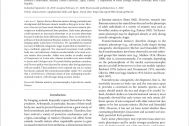Year
2020Authors
Mgr. Radek Michalko, Ph.D.prof. Mgr. Stanislav Pekár, Ph.D.
Species
Leptorchestes berolinensis (C. L. Koch, 1846) VUContent
Species that are Batesian mimics during postembryonic development shift between mimetic models as they grow in size. However, it has not yet been tested whether these successive mimetic phenotypes are similarly protected from predators. Early-instar phenotypes could represent an inaccurate phenotype or an accurate phenotype because of selection from different predators. Here, we tested the hypotheses of transformational Batesian mimicry in the ant-mimicking jumping spider Leptochestes berolinensis. We quantified the mimetic accuracy of different ontogenetic stages to potential ant models by using a multitrait approach. We measured movement, body profile, body size, and coloration. Analysis revealed adults to be more accurate mimics than juveniles. Adults were similar to smaller morphs of Camponotus or Lasius ants, whereas juveniles were more similar to Lasius and Colobopsis ants. We tested whether predators, mantises, and Pisaura spiders were deceived by mimics after having experience with ant models. These predators never captured any ant or a mimic but always captured the nonmyrmecomorphic spider. We conclude that Leptorchestes berolinensis is a Batesian mimic of ants undergoing transformational mimicry, with all stages being accurate mimics.



